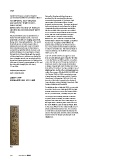Page 396 - Sotheby's October 3 2017 Chinese Art
P. 396
3724
PROPERTY FROM A JAPANESE PRIVATE During the Qing dynasty bianzhong were
COLLECTION FORMED BEFORE WORLD WAR II produced for the court and they became
an essential component of Confucian ritual
AN IMPERIAL GILT-BRONZE ceremonies at the Imperial altars, formal
ARCHAISTIC TEMPLE BELL, banquets and processions. The music produced
BIANZHONG by these instruments was believed to facilitate
MARK AND PERIOD OF KANGXI communication between humans and deities.
(DATED IN ACCORDANCE WITH Gilt-bronze bells of this type were assembled
1715) in sets of sixteen and produced twelve musical
tones, with four tones repeated in a higher
the large bell finely cast, suspended from a or lower octave. Of equal size but varying
double-headed dragon handle, each beast thicknesses, these bells were attached to tall
powerfully cast with eyes bulging and nostrils wooden frames in two rows of eight, as depicted
flaring above long curling whiskers, the mouth by Guiseppe Castiglione (1688-1766) in his
clenched open to reveal its tongue thrust painting Imperial Banquet in Wanshu Garden
between sharp fangs, with a pair of straight (ca. 1755), included in the exhibition Splendors
horns extending back over its head along a of China’s Forbidden City. The Glorious Reign of
combed mane with fine details, the two scaly Emperor Qianlong, The Field Museum, Chicago,
bodies intertwined and crouching in ambush, 2004, cat. no. 101.
the large barrel-shaped body with four panels
of alternating bosses and trigrams, divided by Four sets of bells of this form appear to have
two rectangular panels, one inscribed with the been created during Kangxi’s reign; the first two
characters Kangxi wushisi nian zhi (‘Made in the sets in the 52nd year (1713) and the second two
54th year of Kangxi’) corresponding to 1715, and sets in the 54th year (1715), and are believed to
the other with zhonglü (the sixth tone) have been made for the Temple of Agriculture
33 cm, 13 in. in Beijing. Several bells from the latter sets have
been offered at auction. See two examples, one of
HK$ 600,000-800,000 yingzhong tone and the other of huangzhong tone,
sold in these rooms, 8th April 2010, lot 1858, and
US$ 77,000-103,000 7th October 2010, lot 2105 respectively; a pair,
of yingzhong and ruibin tones, sold at Christie’s
清康熙五十四年 Hong Kong, 1st December 2009, lot 1942; and
鎏金銅交龍鈕八卦紋「仲呂」編鐘 two sets of five bells, formerly in the Audrey B.
Love collection, sold at Christie’s New York, 20th
October 2004, lots 455 and 456.
For bells from the set dated to 1713, see one sold
in our New York rooms, 24th April 1975, lot 240;
and two sold in these rooms, 9th October 2007,
lot 1327, and the other, 17th May 1979, lot 454.
The dragons surmounting this bell are known
as pulao, which according to ancient Chinese
legend is one of the nine sons of the dragon. In
this myth it was said that pulao resided close to
the shore while his arch enemy, the whale, lived
in the ocean. Whenever the whale would come to
attack, pulao would sound a roar. The structure
of a bell is thus associated with this legend; the
clash of the bell, pulao, with the striker, the whale,
would result in the dragon producing its loud
ringing roar.
Mark
394 SOTHEBY’S 蘇富比

